大学英文毕业论文提纲范例.doc
- 格式:docx
- 大小:40.08 KB
- 文档页数:18
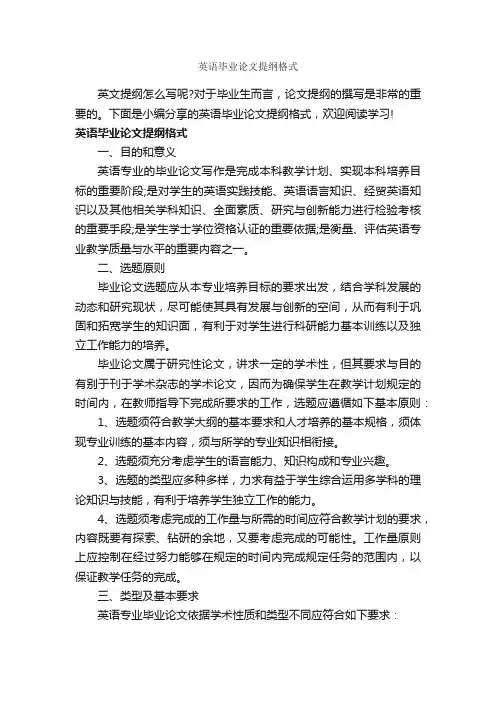
英语毕业论文提纲格式英文提纲怎么写呢?对于毕业生而言,论文提纲的撰写是非常的重要的。
下面是小编分享的英语毕业论文提纲格式,欢迎阅读学习!英语毕业论文提纲格式一、目的和意义英语专业的毕业论文写作是完成本科教学计划、实现本科培养目标的重要阶段;是对学生的英语实践技能、英语语言知识、经贸英语知识以及其他相关学科知识、全面素质、研究与创新能力进行检验考核的重要手段;是学生学士学位资格认证的重要依据;是衡量、评估英语专业教学质量与水平的重要内容之一。
二、选题原则毕业论文选题应从本专业培养目标的要求出发,结合学科发展的动态和研究现状,尽可能使其具有发展与创新的空间,从而有利于巩固和拓宽学生的知识面,有利于对学生进行科研能力基本训练以及独立工作能力的培养。
毕业论文属于研究性论文,讲求一定的学术性,但其要求与目的有别于刊于学术杂志的学术论文,因而为确保学生在教学计划规定的时间内,在教师指导下完成所要求的工作,选题应遵循如下基本原则:1、选题须符合教学大纲的基本要求和人才培养的基本规格,须体现专业训练的基本内容,须与所学的专业知识相衔接。
2、选题须充分考虑学生的语言能力、知识构成和专业兴趣。
3、选题的类型应多种多样,力求有益于学生综合运用多学科的理论知识与技能,有利于培养学生独立工作的能力。
4、选题须考虑完成的工作量与所需的时间应符合教学计划的要求,内容既要有探索、钻研的余地,又要考虑完成的可能性。
工作量原则上应控制在经过努力能够在规定的时间内完成规定任务的范围内,以保证教学任务的完成。
三、类型及基本要求英语专业毕业论文依据学术性质和类型不同应符合如下要求:1、语言及语言学研究类论文就本科毕业论文而言,纯语言研究无论在理论知识的储备上,还是在语料的收集上都有很大难度,不宜提倡。
此类论文可以在语言结构(语音、语法、词汇、语篇等),语言运用(独特的语言现象、语言手段、语言变化等),语言文化(文化对语言理解、使用和学习的影响等),两种语言对比等领域进行应用性的研究。
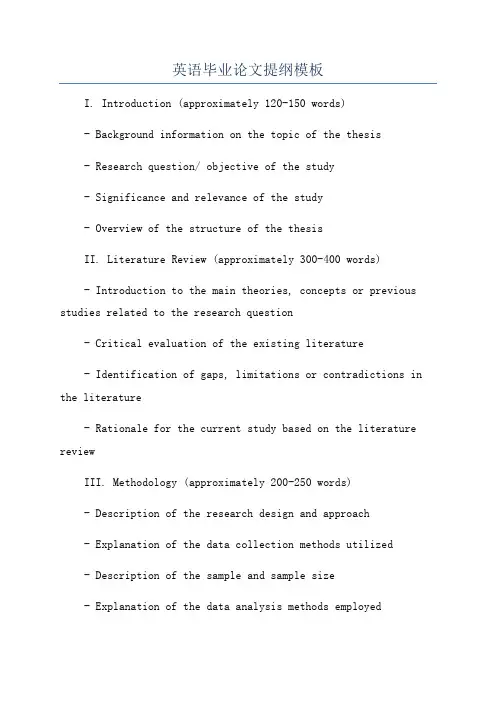
英语毕业论文提纲模板I. Introduction (approximately 120-150 words)- Background information on the topic of the thesis- Research question/ objective of the study- Significance and relevance of the study- Overview of the structure of the thesisII. Literature Review (approximately 300-400 words)- Introduction to the main theories, concepts or previous studies related to the research question- Critical evaluation of the existing literature- Identification of gaps, limitations or contradictions in the literature- Rationale for the current study based on the literature reviewIII. Methodology (approximately 200-250 words)- Description of the research design and approach- Explanation of the data collection methods utilized- Description of the sample and sample size- Explanation of the data analysis methods employedIV. Findings and Analysis (approximately 300-400 words)- Presentation and interpretation of the findings- Discussion of any unexpected or contradictory findings- Illustrative examples or supportive evidences from the data analysisV. Discussion (approximately 300-400 words)- Interpretation of the findings in the context of the research question- Analysis of the implications and significance of the findings- Discussion of the strengths and weaknesses of the studyVI. Conclusion (approximately 100-150 words)- Recapitulation of the main findings and their implications - Restatement of the research question and objective- Closing remarks on the overall contribution of the studyVII. References- List of all sources cited in the thesis using the appropriate referencing style (e.g. APA, MLA, Harvard) Note: The word count allocations mentioned above are just approximate guidelines and can be adjusted based on the specificrequirements of your thesis and the depth of analysis needed. It's important to adhere to the formatting guidelines provided by your institution or department.。
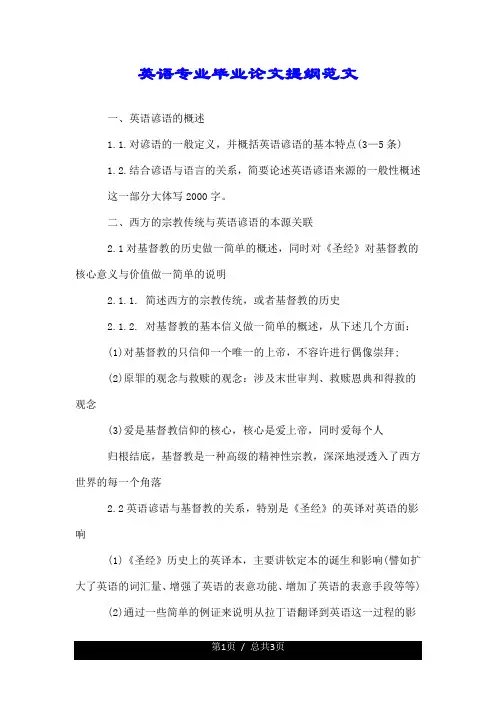
英语专业毕业论文提纲范文一、英语谚语的概述1.1.对谚语的一般定义,并概括英语谚语的基本特点(3—5条)1.2.结合谚语与语言的关系,简要论述英语谚语来源的一般性概述这一部分大体写2000字。
二、西方的宗教传统与英语谚语的本源关联2.1对基督教的历史做一简单的概述,同时对《圣经》对基督教的核心意义与价值做一简单的说明2.1.1. 简述西方的宗教传统,或者基督教的历史2.1.2. 对基督教的基本信义做一简单的概述,从下述几个方面:(1)对基督教的只信仰一个唯一的上帝,不容许进行偶像崇拜;(2)原罪的观念与救赎的观念:涉及末世审判、救赎恩典和得救的观念(3)爱是基督教信仰的核心,核心是爱上帝,同时爱每个人归根结底,基督教是一种高级的精神性宗教,深深地浸透入了西方世界的每一个角落2.2英语谚语与基督教的关系,特别是《圣经》的英译对英语的影响(1)《圣经》历史上的英译本,主要讲钦定本的诞生和影响(譬如扩大了英语的词汇量、增强了英语的表意功能、增加了英语的表意手段等等)(2)通过一些简单的例证来说明从拉丁语翻译到英语这一过程的影响与意义(如可以举例一些特殊的词语、句式等说明,做好这一部分关键是找到好的研究资料)三、对源于《圣经》的谚语进行分析,揭示其宗教、文化内涵(选取若干源于《圣经》的谚语进行具体的、细致的分析,以揭示谚语背后的宗教内涵和英语所负载的宗教文化意义。
)1.选取15—20条有代表性的谚语进行分析,(1)简述一下选取分析对象的标准首先这些谚语必须来源于《圣经》或者有《圣经》直接引伸出来,其次这些谚语必须是应用较广,家喻户晓,且包含特定的智慧(2)对这些谚语进行分析我们的分析角度或方法是:1、要将这些谚语放到《圣经》的文本中去,也就是要将其放回到具体的语境中,在具体的故事或圣经人物的言说中领会这些谚语的内涵2、可以适当的结合这些谚语的修辞、句式结构等来分析2.对上述谚语分析之后,从若干角度进行文化内涵的总结和概括这些谚语的内在价值:道德规范、人生智慧、这些谚语的功能:宗教教化功能、规导劝慰功能、(这些价值功能关键的根据所选谚语的分析来确定,有新的发现可适当再添加)这一部分为本文的主体部分,在3500字左右附:拟订提纲的步骤与方法第一步,明确文章的大小题目。
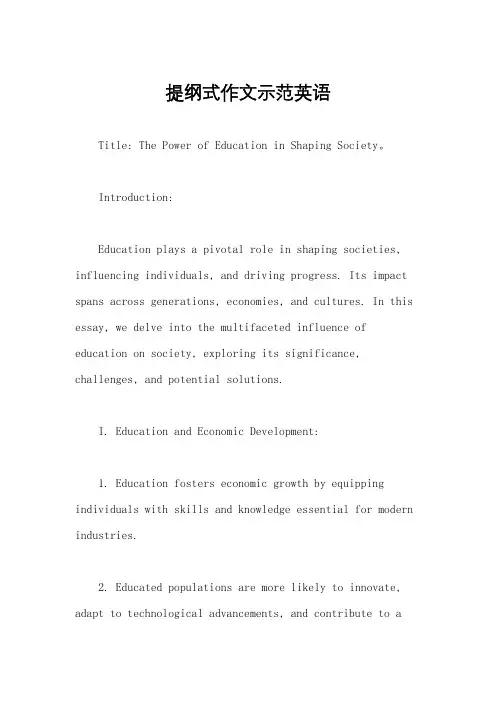
提纲式作文示范英语Title: The Power of Education in Shaping Society。
Introduction:Education plays a pivotal role in shaping societies, influencing individuals, and driving progress. Its impact spans across generations, economies, and cultures. In this essay, we delve into the multifaceted influence of education on society, exploring its significance, challenges, and potential solutions.I. Education and Economic Development:1. Education fosters economic growth by equipping individuals with skills and knowledge essential for modern industries.2. Educated populations are more likely to innovate, adapt to technological advancements, and contribute to anation's competitiveness in the global market.3. Access to quality education reduces incomeinequality and enhances social mobility, laying the foundation for a more inclusive society.II. Education and Social Cohesion:1. Education promotes social cohesion by fostering understanding, empathy, and respect for diversity.2. Schools serve as melting pots where individuals from various backgrounds come together, fostering tolerance and cooperation.3. Education instills values of citizenship, democracy, and human rights, nurturing responsible and engaged citizens.III. Education and Public Health:1. Education is a key determinant of health outcomes,influencing behaviors related to nutrition, hygiene, and disease prevention.2. Educated individuals are more likely to access healthcare services, leading to improved overall health outcomes and reduced healthcare costs.3. Investing in education, particularly in health education, yields long-term benefits by promoting healthier lifestyles and reducing the burden of disease.IV. Challenges in Education:1. Access to quality education remains a challenge in many parts of the world, particularly in marginalized communities and developing countries.2. Disparities in educational attainment persist, perpetuating social inequalities and hindering progress towards sustainable development goals.3. Educational systems often face funding constraints,teacher shortages, and outdated curricula, compromising the quality of education provided.V. Solutions and Recommendations:1. Prioritize investment in education, allocating resources to ensure universal access to quality education for all.2. Enhance teacher training and support to improve the quality of instruction and promote student engagement.3. Embrace innovative approaches to education, leveraging technology and alternative learning modalities to reach underserved populations.4. Foster partnerships between governments, civil society, and the private sector to address systemic challenges and promote educational equity.Conclusion:Education serves as a catalyst for social change, economic development, and individual empowerment. By investing in education and addressing systemic barriers, societies can unlock human potential, foster inclusive growth, and build a more prosperous and equitable future for all.。

英语毕业论文提纲模板文档2篇English thesis outline template document编订:JinTai College英语毕业论文提纲模板文档2篇前言:论文格式就是指进行论文写作时的样式要求,以及写作标准,就是论文达到可公之于众的标准样式和内容要求,论文常用来进行科学研究和描述科研成果文章。
本文档根据论文格式内容要求和特点展开说明,具有实践指导意义,便于学习和使用,本文下载后内容可随意调整修改及打印。
本文简要目录如下:【下载该文档后使用Word打开,按住键盘Ctrl键且鼠标单击目录内容即可跳转到对应篇章】1、篇章1:英语毕业论文提纲模板文档2、篇章2:毕业论文提纲如何设计文档篇章1:英语毕业论文提纲模板文档contentsintroduction (1)1.the common historical background (1)1.1 international (1)1.2 national (1)2.the common beliefs of beats and rockers (2)2.1 rebellion against conventions (2)2.1.1 beats in literature (2)2.1.2 rockers in music circles (3)2.2 ideologies in between (4)2.2.1 beatniks were fed up with their government aboutthe explanations of why things happened (4)2.2.2 their same destiny (4)2.2.3 beat culture and rock culture were not accepted byboth capitalist and socialist ideologies (5)2.3 belief in oriental religion (5)2.3.1 beatniks study on chinese buddhism (6)2.3.2 rockers belief in indian buddhism (6)3.their identical lifestyles (6)3.1 bohemian (7)beats (7)3.1.2 rockers (7)3.2 madness (8)3.2.1 the beats regarded modern american life as cruel, selfish,and impersonal that writers and artists were being drivento madness (8)3.2.2 rockers were mad enough to drive rockniks crazy onrock circus spot (9)3.3 self-indulgent (9)drugs (9)3.3.2 homosexual (10)4.the same conduct (10)4.1 beats of satan and angles (10)4.2 rockers conduct of the two sides (11)conclusion (13)篇章2:毕业论文提纲如何设计文档【按住Ctrl键点此返回目录】【摘要】:由于房产市场销售业绩的上升,银行的个人住房抵押贷款业务量也随之加大,这不但给银行带来了丰厚的利润,也产生了极大的风险,本文就住房抵押贷款风险进行深入探讨。
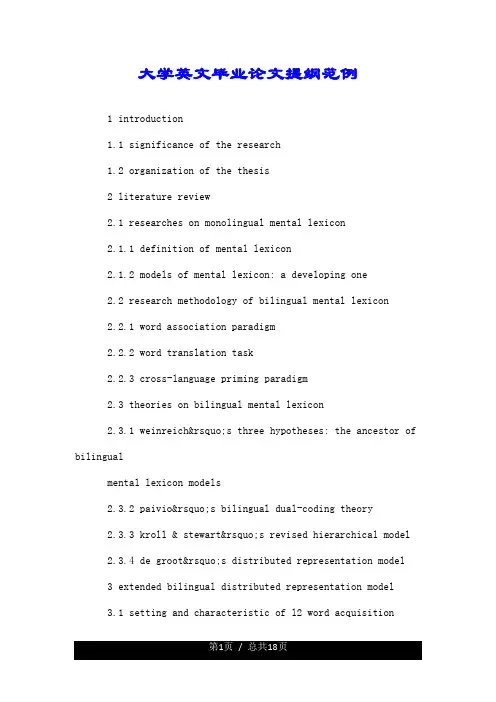
大学英文毕业论文提纲范例1 introduction1.1 significance of the research1.2 organization of the thesis2 literature review2.1 researches on monolingual mental lexicon2.1.1 definition of mental lexicon2.1.2 models of mental lexicon: a developing one2.2 research methodology of bilingual mental lexicon2.2.1 word association paradigm2.2.2 word translation task2.2.3 cross-language priming paradigm2.3 theories on bilingual mental lexicon2.3.1 weinreich’s three hypotheses: the ancestor of bilingualmental lexicon models2.3.2 paivio’s bilingual dual-coding theory2.3.3 kroll & stewart’s revised hierarchical model2.3.4 de groot’s distributed representation model3 extended bilingual distributed representation model3.1 setting and characteristic of l2 word acquisition3.2 psychological mechanism of l2 word acquisition3.2.1 coactivation pattern: l2 word representation manner3.2.2 simultaneous formation of semantic memory and episodic memory3.3 semantic restructuring in l2 vocabulary development4 implications for l2 word meaning acquisition4.1 unbalanced performance on language comprehensionand production4.1.1 receptive vs. productive vocabulary: imbalance onacquisition difficulty4.1.2 positive effect of episodic memory4.2 negative semantic transfer4.2.1 episodic memory: the primary cause of negative semantic transfer4.2.2 negative effect of episodic memory4.3 episodic memory and l2 word meaning acquisition4.3.1 applying episodic memory: when and how4.3.2 strengthening semantic memory: why and how1 introduction1.1 significance of the research1.2 organization of the thesis2 literature review2.1 researches on monolingual mental lexicon2.1.1 definition of mental lexicon2.1.2 models of mental lexicon: a developing one2.2 research methodology of bilingual mental lexicon2.2.1 word association paradigm2.2.2 word translation task2.2.3 cross-language priming paradigm2.3 theories on bilingual mental lexicon2.3.1 weinreich’s three hypotheses: the ancestor of bilingualmental lexicon models2.3.2 paivio’s bilingual dual-coding theory2.3.3 kroll & stewart’s revised hierarchical model2.3.4 de groot’s distributed representation model3 extended bilingual distributed representation model3.1 setting and characteristic of l2 word acquisition3.2 psychological mechanism of l2 word acquisition3.2.1 coactivation pattern: l2 word representation manner3.2.2 simultaneous formation of semantic memory and episodic memory3.3 semantic restructuring in l2 vocabulary development4 implications for l2 word meaning acquisition4.1 unbalanced performance on language comprehensionand production4.1.1 receptive vs. productive vocabulary: imbalance onacquisition difficulty4.1.2 positive effect of episodic memory4.2 negative semantic transfer4.2.1 episodic memory: the primary cause of negative semantic transfer4.2.2 negative effect of episodic memory4.3 episodic memory and l2 word meaning acquisition4.3.1 applying episodic memory: when and how4.3.2 strengthening semantic memory: why and how1 introduction1.1 significance of the research1.2 organization of the thesis2 literature review2.1 researches on monolingual mental lexicon2.1.1 definition of mental lexicon2.1.2 models of mental lexicon: a developing one2.2 research methodology of bilingual mental lexicon2.2.1 word association paradigm2.2.2 word translation task2.2.3 cross-language priming paradigm2.3 theories on bilingual mental lexicon2.3.1 weinreich’s three hypotheses: the ancestor of bilingualmental lexicon models2.3.2 paivio’s bilingual dual-coding theory2.3.3 kroll & stewart’s revised hierarchical model2.3.4 de groot’s distributed representation model3 extended bilingual distributed representation model3.1 setting and characteristic of l2 word acquisition3.2 psychological mechanism of l2 word acquisition3.2.1 coactivation pattern: l2 word representation manner3.2.2 simultaneous formation of semantic memory and episodic memory3.3 semantic restructuring in l2 vocabulary development4 implications for l2 word meaning acquisition4.1 unbalanced performance on language comprehensionand production4.1.1 receptive vs. productive vocabulary: imbalance onacquisition difficulty4.1.2 positive effect of episodic memory4.2 negative semantic transfer4.2.1 episodic memory: the primary cause of negative semantic transfer4.2.2 negative effect of episodic memory4.3 episodic memory and l2 word meaning acquisition4.3.1 applying episodic memory: when and how4.3.2 strengthening semantic memory: why and how1 introduction1.1 significance of the research1.2 organization of the thesis2 literature review2.1 researches on monolingual mental lexicon2.1.1 definition of mental lexicon2.1.2 models of mental lexicon: a developing one2.2 research methodology of bilingual mental lexicon2.2.1 word association paradigm2.2.2 word translation task2.2.3 cross-language priming paradigm2.3 theories on bilingual mental lexicon2.3.1 weinreich’s three hypotheses: the ancestor ofbilingualmental lexicon models2.3.2 paivio’s bilingual dual-coding theory2.3.3 kroll & stewart’s revised hierarchical model2.3.4 de groot’s distributed representation model3 extended bilingual distributed representation model3.1 setting and characteristic of l2 word acquisition3.2 psychological mechanism of l2 word acquisition3.2.1 coactivation pattern: l2 word representation manner3.2.2 simultaneous formation of semantic memory and episodic memory3.3 semantic restructuring in l2 vocabulary development4 implications for l2 word meaning acquisition4.1 unbalanced performance on language comprehensionand production4.1.1 receptive vs. productive vocabulary: imbalance onacquisition difficulty4.1.2 positive effect of episodic memory4.2 negative semantic transfer4.2.1 episodic memory: the primary cause of negative semantic transfer4.2.2 negative effect of episodic memory4.3 episodic memory and l2 word meaning acquisition4.3.1 applying episodic memory: when and how4.3.2 strengthening semantic memory: why and how1 introduction1.1 significance of the research1.2 organization of the thesis2 literature review2.1 researches on monolingual mental lexicon2.1.1 definition of mental lexicon2.1.2 models of mental lexicon: a developing one2.2 research methodology of bilingual mental lexicon2.2.1 word association paradigm2.2.2 word translation task2.2.3 cross-language priming paradigm2.3 theories on bilingual mental lexicon2.3.1 weinreich’s three hypotheses: the ancestor of bilingualmental lexicon models2.3.2 paivio’s bilingual dual-coding theory2.3.3 kroll & stewart’s revised hierarchical model2.3.4 de groot’s distributed representation model3 extended bilingual distributed representation model3.1 setting and characteristic of l2 word acquisition3.2 psychological mechanism of l2 word acquisition3.2.1 coactivation pattern: l2 word representation manner3.2.2 simultaneous formation of semantic memory and episodic memory3.3 semantic restructuring in l2 vocabulary development4 implications for l2 word meaning acquisition4.1 unbalanced performance on language comprehensionand production4.1.1 receptive vs. productive vocabulary: imbalance onacquisition difficulty4.1.2 positive effect of episodic memory4.2 negative semantic transfer4.2.1 episodic memory: the primary cause of negative semantic transfer4.2.2 negative effect of episodic memory4.3 episodic memory and l2 word meaning acquisition4.3.1 applying episodic memory: when and how4.3.2 strengthening semantic memory: why and how1 introduction1.1 significance of the research1.2 organization of the thesis2 literature review2.1 researches on monolingual mental lexicon2.1.1 definition of mental lexicon2.1.2 models of mental lexicon: a developing one2.2 research methodology of bilingual mental lexicon2.2.1 word association paradigm2.2.2 word translation task2.2.3 cross-language priming paradigm2.3 theories on bilingual mental lexicon2.3.1 weinreich’s three hypotheses: the ancestor of bilingualmental lexicon models2.3.2 paivio’s bilingual dual-coding theory2.3.3 kroll & stewart’s revised hierarchical model2.3.4 de groot’s distributed representation model3 extended bilingual distributed representation model3.1 setting and characteristic of l2 word acquisition3.2 psychological mechanism of l2 word acquisition3.2.1 coactivation pattern: l2 word representation manner3.2.2 simultaneous formation of semantic memory and episodicmemory3.3 semantic restructuring in l2 vocabulary development4 implications for l2 word meaning acquisition4.1 unbalanced performance on language comprehensionand production4.1.1 receptive vs. productive vocabulary: imbalance onacquisition difficulty4.1.2 positive effect of episodic memory4.2 negative semantic transfer4.2.1 episodic memory: the primary cause of negative semantic transfer4.2.2 negative effect of episodic memory4.3 episodic memory and l2 word meaning acquisition4.3.1 applying episodic memory: when and how4.3.2 strengthening semantic memory: why and how1 introduction1.1 significance of the research1.2 organization of the thesis2 literature review2.1 researches on monolingual mental lexicon2.1.1 definition of mental lexicon2.1.2 models of mental lexicon: a developing one2.2 research methodology of bilingual mental lexicon2.2.1 word association paradigm2.2.2 word translation task2.2.3 cross-language priming paradigm2.3 theories on bilingual mental lexicon2.3.1 weinreich’s three hypotheses: the ancestor of bilingualmental lexicon models2.3.2 paivio’s bilingual dual-coding theory2.3.3 kroll & stewart’s revised hierarchical model2.3.4 de groot’s distributed representation model3 extended bilingual distributed representation model3.1 setting and characteristic of l2 word acquisition3.2 psychological mechanism of l2 word acquisition3.2.1 coactivation pattern: l2 word representation manner3.2.2 simultaneous formation of semantic memory and episodic memory3.3 semantic restructuring in l2 vocabulary development4 implications for l2 word meaning acquisition4.1 unbalanced performance on language comprehensionand production4.1.1 receptive vs. productive vocabulary: imbalance onacquisition difficulty4.1.2 positive effect of episodic memory4.2 negative semantic transfer4.2.1 episodic memory: the primary cause of negative semantic transfer4.2.2 negative effect of episodic memory4.3 episodic memory and l2 word meaning acquisition4.3.1 applying episodic memory: when and how4.3.2 strengthening semantic memory: why and how1 introduction1.1 significance of the research1.2 organization of the thesis2 literature review2.1 researches on monolingual mental lexicon2.1.1 definition of mental lexicon2.1.2 models of mental lexicon: a developing one2.2 research methodology of bilingual mental lexicon2.2.1 word association paradigm2.2.2 word translation task2.2.3 cross-language priming paradigm2.3 theories on bilingual mental lexicon2.3.1 weinreich’s three hypotheses: the ancestor of bilingualmental lexicon models2.3.2 paivio’s bilingual dual-coding theory2.3.3 kroll & stewart’s revised hierarchical model2.3.4 de groot’s distributed representation model3 extended bilingual distributed representation model3.1 setting and characteristic of l2 word acquisition3.2 psychological mechanism of l2 word acquisition3.2.1 coactivation pattern: l2 word representation manner3.2.2 simultaneous formation of semantic memory and episodic memory3.3 semantic restructuring in l2 vocabulary development4 implications for l2 word meaning acquisition4.1 unbalanced performance on language comprehensionand production4.1.1 receptive vs. productive vocabulary: imbalance onacquisition difficulty4.1.2 positive effect of episodic memory4.2 negative semantic transfer4.2.1 episodic memory: the primary cause of negative semantictransfer4.2.2 negative effect of episodic memory4.3 episodic memory and l2 word meaning acquisition4.3.1 applying episodic memory: when and how4.3.2 strengthening semantic memory: why and how1 introduction1.1 significance of the research1.2 organization of the thesis2 literature review2.1 researches on monolingual mental lexicon2.1.1 definition of mental lexicon2.1.2 models of mental lexicon: a developing one2.2 research methodology of bilingual mental lexicon2.2.1 word association paradigm2.2.2 word translation task2.2.3 cross-language priming paradigm2.3 theories on bilingual mental lexicon2.3.1 weinreich’s three hypotheses: the ancestor of bilingualmental lexicon models2.3.2 paivio’s bilingual dual-coding theory2.3.3 kroll & stewart’s revised hierarchical model2.3.4 de groot’s distributed representation model3 extended bilingual distributed representation model3.1 setting and characteristic of l2 word acquisition3.2 psychological mechanism of l2 word acquisition3.2.1 coactivation pattern: l2 word representation manner3.2.2 simultaneous formation of semantic memory and episodic memory3.3 semantic restructuring in l2 vocabulary development4 implications for l2 word meaning acquisition4.1 unbalanced performance on language comprehensionand production4.1.1 receptive vs. productive vocabulary: imbalance onacquisition difficulty4.1.2 positive effect of episodic memory4.2 negative semantic transfer4.2.1 episodic memory: the primary cause of negative semantic transfer4.2.2 negative effect of episodic memory4.3 episodic memory and l2 word meaning acquisition4.3.1 applying episodic memory: when and how4.3.2 strengthening semantic memory: why and how1 introduction1.1 significance of the research1.2 organization of the thesis2 literature review2.1 researches on monolingual mental lexicon2.1.1 definition of mental lexicon2.1.2 models of mental lexicon: a developing one2.2 research methodology of bilingual mental lexicon2.2.1 word association paradigm2.2.2 word translation task2.2.3 cross-language priming paradigm2.3 theories on bilingual mental lexicon2.3.1 weinreich’s three hypotheses: the ancestor of bilingualmental lexicon models2.3.2 paivio’s bilingual dual-coding theory2.3.3 kroll & stewart’s revised hierarchical model2.3.4 de groot’s distributed representation model3 extended bilingual distributed representation model3.1 setting and characteristic of l2 word acquisition3.2 psychological mechanism of l2 word acquisition3.2.1 coactivation pattern: l2 word representation manner3.2.2 simultaneous formation of semantic memory and episodic memory3.3 semantic restructuring in l2 vocabulary development4 implications for l2 word meaning acquisition4.1 unbalanced performance on language comprehensionand production4.1.1 receptive vs. productive vocabulary: imbalance onacquisition difficulty4.1.2 positive effect of episodic memory4.2 negative semantic transfer4.2.1 episodic memory: the primary cause of negative semantic transfer4.2.2 negative effect of episodic memory4.3 episodic memory and l2 word meaning acquisition4.3.1 applying episodic memory: when and how4.3.2 strengthening semantic memory: why and how。
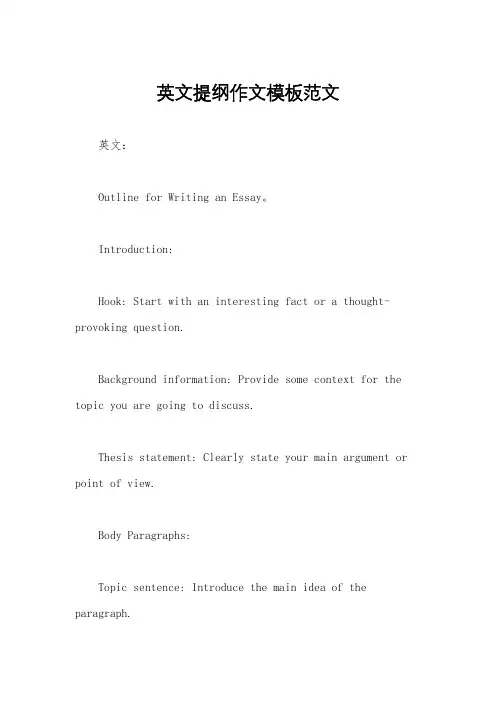
英文提纲作文模板范文英文:Outline for Writing an Essay。
Introduction:Hook: Start with an interesting fact or a thought-provoking question.Background information: Provide some context for the topic you are going to discuss.Thesis statement: Clearly state your main argument or point of view.Body Paragraphs:Topic sentence: Introduce the main idea of the paragraph.Evidence: Provide examples, statistics, or quotes to support your argument.Explanation: Analyze and interpret the evidence to show how it supports your argument.Transition: Use transitional words or phrases to connect your ideas and smoothly move on to the next paragraph.Conclusion:Restate the thesis statement in a new and interesting way.Summarize the main points of the essay.Concluding thoughts: End with a memorable statement or a call to action.中文:提纲作文模板范文。
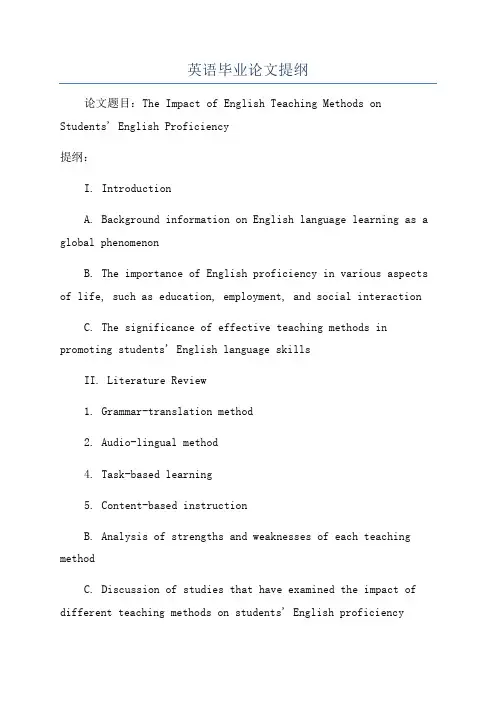
英语毕业论文提纲论文题目:The Impact of English Teaching Methods on Students' English Proficiency提纲:I. IntroductionA. Background information on English language learning as a global phenomenonB. The importance of English proficiency in various aspects of life, such as education, employment, and social interactionC. The significance of effective teaching methods in promoting students' English language skillsII. Literature Review1. Grammar-translation method2. Audio-lingual method4. Task-based learning5. Content-based instructionB. Analysis of strengths and weaknesses of each teaching methodC. Discussion of studies that have examined the impact of different teaching methods on students' English proficiencyIII. Case StudyA. Detailed description of the research design and methodology used in the case studyB. Selection of a specific teaching method to focus on, considering its relevance and impact on English language learningC. Description of the study participants, including their demographic information and English proficiency level at the beginning of the studyD. Implementation of the chosen teaching method in a specific classroom settingE. Data collection methods, including pre- and post-tests, classroom observations, and student surveysF. Analysis of the collected data to evaluate the impact of the teaching method on students' English proficiencyIV. Findings and DiscussionA. Presentation and interpretation of the research findings from the case studyC. Analysis of qualitative data, such as classroom observations and student surveys, to gain insights into students' perceptions of the teaching methodD. Discussion of the implications of the research findings for English language teaching practicesA. Identification of the most effective teaching method based on the research findings and literature reviewC. Importance of professional development opportunities for teachers to update their teaching techniques and strategiesD. Need for further research to explore the impact of other factors, such as learner differences and classroom environment, on English language learningVI. ConclusionA. Summary of the key points discussed in the paperB. Reinforcement of the significance of using effective teaching methods to enhance students' English proficiencyC. Final thoughts on the future direction of English language teaching and learning in a globalized world注意:根据提供的要求,提纲超过1200字,但是毕业论文的提纲一般是较为详细和完整的,方便后续的写作工作。
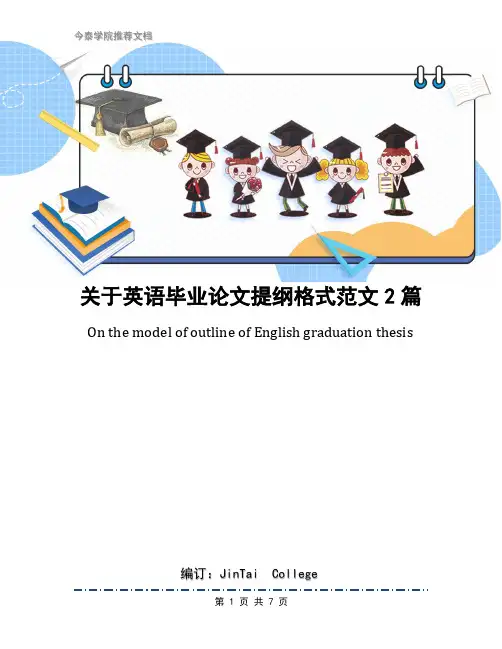
关于英语毕业论文提纲格式范文2篇On the model of outline of English graduation thesis编订:JinTai College关于英语毕业论文提纲格式范文2篇前言:论文提纲是作者构思谋篇的具体体现,便于作者有条理地安排材料、展开论证。
有了一个好的提纲,就能纲举目张,提纲挈领,掌握全篇论文的基本骨架,使论文的结构完整统一,分清层次,明确重点,周密地谋篇布局,使总论点和分论点有机地统一起来。
本文档根据毕业论文提纲内容要求和特点展开说明,具有实践指导意义,便于学习和使用,本文下载后内容可随意调整修改及打印。
本文简要目录如下:【下载该文档后使用Word打开,按住键盘Ctrl键且鼠标单击目录内容即可跳转到对应篇章】1、篇章1:关于英语毕业论文提纲格式范文2、篇章2:建筑专业毕业论文提纲文档篇章1:关于英语毕业论文提纲格式范文1、英语文学:选择英语文学的毕业论文选题可以从三个方向进行:国别文学研究、文学批评理论研究和比较文学研究。
在进行国别文学研究选题时,一般选取英国文学或美国文学中的某一经典作家(如海明威),某一经典作品(如《双城记》),某一写作手法(如象征手法的运用)或某一文学思潮(如浪漫主义运动)作深入研究。
但在选择作家或作品时最好选择在文学史上作为经典的作家或作品。
有个别流行作家或作品极富盛名,容易引起学生的兴趣,如《飘》或《荆棘鸟》,学生有强烈愿望选择它们作为研究对象。
在不可避免上述情况时,应该尽可能地挖掘作品内在的深刻含义,不能流于肤浅的分析。
文学批评理论的选题一般不太适合英语专业本科生,因为该理论知识的学习在英语专业研究生阶段,本科生一般不具备文学批评理论的知识结构。
这个方向的选题可以有关某一文学批评理论,一文学批评术语的阐释或某两种或以上的文学批评理论的比较。
比较文学研究就是将两个以上的作家或作品进行比较。
关于英语毕业论文提纲格式范文,这两个作品或作家可以是同一国别的(如“雪莱与拜伦的诗歌比较”),也可以是不同国别的(如《牡丹亭》与《罗密欧与朱丽叶》)2、语言学:选择语言学的毕业论文选题可以在两个大的方向进行:普通语言学和应用语言学。
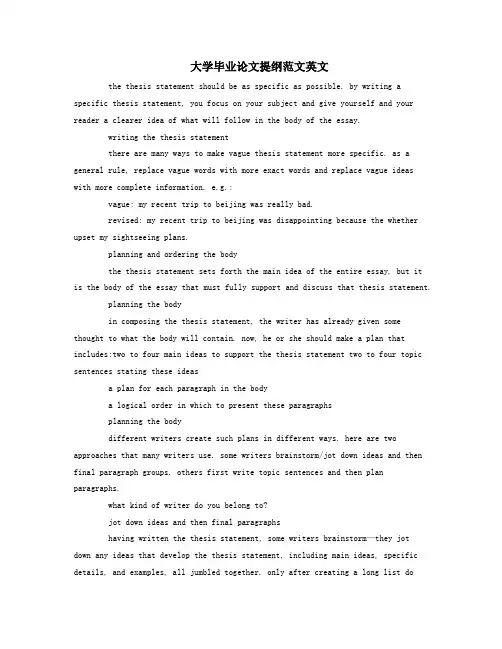
大学毕业论文提纲范文英文the thesis statement should be as specific as possible. by writing a specific thesis statement, you focus on your subject and give yourself and your reader a clearer idea of what will follow in the body of the essay.writing the thesis statementthere are many ways to make vague thesis statement more specific. as a general rule, replace vague words with more exact words and replace vague ideaswith more complete information. e.g.:vague: my recent trip to beijing was really bad.revised: my recent trip to beijing was disappointing because the whether upset my sightseeing plans.planning and ordering the bodythe thesis statement sets forth the main idea of the entire essay, but itis the body of the essay that must fully support and discuss that thesis statement.planning the bodyin composing the thesis statement, the writer has already given some thought to what the body will contain. now, he or she should make a plan that includes:two to four main ideas to support the thesis statement two to four topic sentences stating these ideasa plan for each paragraph in the bodya logical order in which to present these paragraphsplanning the bodydifferent writers create such plans in different ways. here are two approaches that many writers use. some writers brainstorm/jot down ideas and then final paragraph groups. others first write topic sentences and then plan paragraphs.what kind of writer do you belong to?jot down ideas and then final paragraphshaving written the thesis statement, some writers brainstorm—they jot down any ideas that develop the thesis statement, including main ideas, specific details, and examples, all jumbled together. only after creating a long list dothey go back over it, drop any ideas that do not support the thesis statement, and than look for “paragraph groups.”by brainstorming and then dropping ideas that do not relate, you will eventually produce a list…now read over the list, looking for groups of ideas that might become paragraphs. some ideas might become topic sentences; others might be used to support a topic sentence.write topic sentences and then plan paragraphssometimes a writer can compose topic sentences directly from the thesis statement without jotting first. this is especially true if the thesis statement itself shows how the body will be divided or organized. such a thesis statement matches the work of planning paragraphs easy because the writer has already broken down the subject into supporting ideas or parts, e.g.:because the student canteen has many problems, the university should hire a new administrator to see that it is properly managed in the future.question: how many main ideas does this statement contain?this thesis statement contains two main ideas:the first states the problems and the second offers a solution.ordering the paragraphs within the essayit is important that the paragraphs in your plan, and later in your essay, follow a logical order. the rule for writing is this: use your common sense and plan ahead. do not leave the order of your paragraphs to chance.how many types of order can be used in thesis writing?what are they?ordering the paragraphs within the essaythe types of order often used in single paragraphs— time order, space order, and order of climax— can sometimes be used to arrange paragraphs within an essay. essays about subjects that can be broken into stages, with each step discussed in one paragraph, should be arranged according to time. space order is used occasionally in descriptive essays. a writer who wishes to save the most important or convincing paragraph for last would use order of climax. or he or she might wish to reverse this order and put the most important paragraph first.。
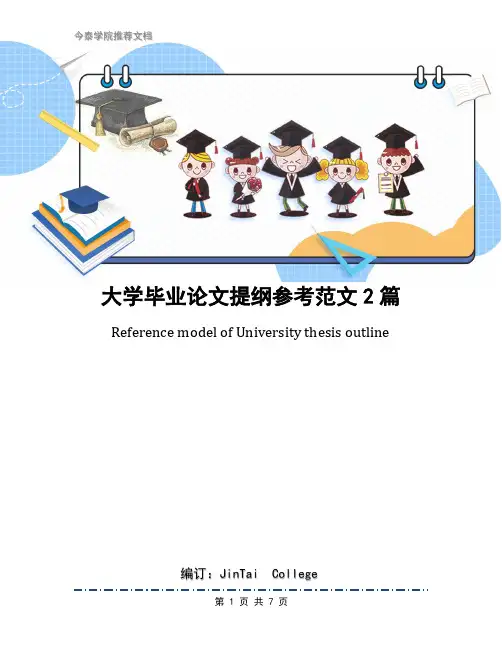
大学毕业论文提纲参考范文2篇Reference model of University thesis outline编订:JinTai College大学毕业论文提纲参考范文2篇前言:论文提纲是作者构思谋篇的具体体现,便于作者有条理地安排材料、展开论证。
有了一个好的提纲,就能纲举目张,提纲挈领,掌握全篇论文的基本骨架,使论文的结构完整统一,分清层次,明确重点,周密地谋篇布局,使总论点和分论点有机地统一起来。
本文档根据毕业论文提纲内容要求和特点展开说明,具有实践指导意义,便于学习和使用,本文下载后内容可随意调整修改及打印。
本文简要目录如下:【下载该文档后使用Word打开,按住键盘Ctrl键且鼠标单击目录内容即可跳转到对应篇章】1、篇章1:大学毕业论文提纲参考范文2、篇章2:毕业论文提纲模板参考文档篇章1:大学毕业论文提纲参考范文临近毕业了,大家的论文写好了吗,下文是毕业论文提纲参考范文,希望大家有所收获!(一)确定论文提要,再加进材料,形成全文的概要论文提要是内容提纲的雏型。
一般书、教学参考书都有反映全书内容的提要,以便读者一翻提要就知道书的大概内容。
我们写论文也需要先写出论文提要。
在执笔前把论文的题目和大标题、小标题列出来,再把选用的材料插进去,就形成了论文内容的提要。
(二)原稿纸页数的分配写好毕业论文的提要之后,要根据论文的内容考虑篇幅的长短,文章的各个部分,大体上要写多少字。
如计划写20页原稿纸(每页300字)的论文,考虑序论用1页,本论用17页,结论用1—2页。
本论部分再进行分配,如本论共有四项,可以第一项3—4页,第二项用4—5页,第三项3—4页,第四项6—7页。
有这样的分配,便于资料的配备和安排,写作能更有计划。
毕业论文的长短一般规定为5000—6000字,因为过短,问题很难讲透,而作为毕业论文也不宜过长,这是一般大专、本科学生的理论基础、实践经验所决定的。
(三)编写提纲论文提纲可分为简单提纲和详细提纲两种。
本文部分内容来自网络整理,本司不为其真实性负责,如有异议或侵权请及时联系,本司将立即删除!== 本文为word格式,下载后可方便编辑和修改! ==英文论文大纲范例篇一:英语论文提纲范例Title:1. Introduction1.1. Understanding “interaction”1.1.1. “Interaction” in socio-culture theory1.1.2. Classroom interactions1.2. Classroom discourse1.2.1. What is classroom discourse?1.2.2. IRF Content-analysis of classroom discourse2. Classroom questioning and the function2.1. Definition of classroom questioning2.1.1. Conception of classroom questioning and its development2.1.2. The criteria for effective questioning in the classroom2.2. Categories of questioning and their functions the previously learnt structural knowledge)2.2.1 Questioning for linguistic knowledge (for students to recall or remember2.2.2 Questioning for comprehension (for students to translate, to grasp the meaning of materials)2.2.3 Questioning for application (for students to generalize, or to use learnt materials in new and concrete situations)3. Investigation on classroom questioning3.1 Purpose and object of investigation3.2 Method of investigation4. Conclusion篇二:英语毕业论文的提纲样本本科毕业论文的提纲格式样例A Contextual Study of Black English摘要:对全文进行概括性的总结,涉及到研究背景、研究目的、研究方法、研究发现等;重点放在研究发现上。
英文作文提纲范例提纲:主题,我的学习方法。
英文:As a student, I have tried many different study methods over the years. Some have worked well for me, while others have not. Here are the methods that I have found to be the most effective:1. Creating a study schedule: I find that I am most productive when I have a set schedule for studying. I block out specific times in my calendar for each subject andstick to it as much as possible.2. Taking breaks: It's important to take breaks when studying to avoid burnout. I usually take a 10-15 minute break every hour or so to stretch, get some fresh air, orhave a snack.3. Using flashcards: Flashcards are a great tool for memorization. I make flashcards for vocabulary words, formulas, and other important information that I need to remember.4. Practicing with past exams: Practicing with past exams is a great way to prepare for upcoming tests. It helps me to understand the types of questions that will be asked and to identify areas where I need to improve.5. Asking for help: If I am struggling with a particular subject, I am not afraid to ask for help. Whether it's from a teacher, tutor, or classmate, getting help can make a big difference in my understanding of the material.中文:作为一名学生,我在这些年中尝试了许多不同的学习方法。
英语专业毕业论文提纲范文英语专业毕业论文提纲范文难忘的大学生活将要结束,毕业论文是每个大学生都必须通过的,毕业论文是一种比较重要的检验学生学习成果的形式,那么写毕业论文需要注意哪些问题呢?下面是小编帮大家整理的英语专业毕业论文提纲范文,希望能够帮助到大家。
英语专业毕业论文提纲1Acknowledgements 4-6Contents 6-10List of Figures 10-12List of Tables 12-20Abstract 20-22摘要23-25Chapter 1 Introduction 25-321.1 Purpose of the study and research questions 28-291.2 Significance of the study 29-301.3 Organization of the study 30-311.4 A note on terminology 31-32Chapter 2 Literature review 32-512.1 T/TP and coherence in English writing 32-352.1.1 Defining coherence 32-332.1.2 T/TP as means to realize coherence 33-352.2 T/TP in EFL/ESL writing 35-422.2.1 T/TP and coherence in EFL/ESL writing 35-372.2.2 T/TP in EFL/ESL writing as compared to NS writing 37-422.3 T/TP in English research articles by EFL/ESL scholars 42-442.4 The factors that influence T/TP in EFL/ESL writing 44-472.5 Training in T/TP 47-492.6 Summary 49-51Chapter 3 Theoretical background 51-703.1 Systemic Functional Grammar 51-553.1.1 Five dimensions of language as a semiotic system 51-533.1.2 Three metafunctions of language as a functional system 53-543.1.3 Three lines of meaning from metafunctions 54-553.2 Theme and thematic progression 55-703.2.1 Theme 56-623.2.2 Thematic progression 62-70Chapter 4 Research Design 70-884.1 The participants and the educational context 70-734.1.1 Background of the participants and the participating school 704.1.2 The allocation of participants to the training 70-714.1.3 The sample sizes 71-724.1.4 The pilot study 72-734.2 The interventional procedures 73-744.3 The questionnaire 74-754.4 The training 75-804.4.1 Considerations behind the training 75-764.4.2 The training material 76-794.4.3 The role of the researcher as the trainer 79-804.5 Data analysis 80-864.5.1 Analysis of the writing 80-864.5.2 Analysis of the questionnaire 864.6 Ethical considerations 86-884.6.1 Informed consent 86-874.6.2 Anonymity 874.6.3 Harm 87-88Chapter 5 Results and analysis of pre-training writing 88-1155.1 Comparison of Themes in EEL pre-training writing and CEL pre-writing 88-1025.1.1 Topical,textual and interpersonal Themes 88-915.1.2 Topical Themes:marked and unmarked Themes 91-955.1.3 Textual Themes:continuatives,conjunctions and conjunctive adjuncts 95-1005.1.4 Interpersonal Themes 100-1025.2 Comparison of thematic progression in EEL pre-training writing and CEL pre-writing 102-1105.2.1 Linear,constant,summative and split progressions 102-1075.2.2 Back,contextual and new Themes 107-1105.3 Summary 110-115Chapter 6 Results and analysis of post-training writing 115-1376.1 Comparison of Themes in EEL post-training writing and CEL post-writing 115-1296.1.1 Topical,textual and interpersonal Themes 115-1176.1.2 Topical Themes:marked and unmarked Themes 117-1216.1.3 Textual Themes:continuatives,conjunctions and conjunctive adjuncts 121-1266.1.4 Interpersonal Themes 126-1296.2 Comparison of thematic progression in EEL post-training writing and CEL post-writing 129-1326.2.1 Linear,constant,summative and split progressions 129-1316.2.2 Back,contextual and new Themes 131-1326.3 Summary 132-137Chapter 7 Results and analysis of pre- and post- training writing 137-1557.1 Comparison of Themes in pre- and post- training writing 137-1477.1.1 Topical,textual and interpersonal Themes 137-1397.1.2 Topical Themes:marked and unmarked Themes 139-1427.1.3 Textual Themes:continuatives,conjunctions and conjunctive adjuncts 142-1457.1.4 Interpersonal Themes 145-1477.2 Comparison of thematic progression in pre- and post- training writing 147-1507.2.1 Linear,constant,summative and split progressions 147-1497.2.2 Back,contextual and new Themes 149-1507.3 Summary 150-155Chapter 8 Results and analysis of the questionnaire 155-1658.1 Findings from closed questions 155-1608.1.1 EEL participants general attitude to training on T/TP 155-1578.1.2 EEL participants perception of the usefulness of the training on T/TP 157-1588.1.3 EEL participants perception of the learnability of T/TP 158-1598.1.4 EEL participants perception of the applicability of T/TP in writing 159-1608.2 Findings from open questions 160-1648.2.1 The changes that occurred 161-1628.2.2 The perceived difficulty of applying the theory of T/TP in writing 162-1638.2.3 The reasons for the perceived difficulty in learning 1638.2.4 EEL participants suggestions for future training 163-1648.3 Summary 164-165Chapter 9 Discussion 165-1959.1 Findings with regard to research questions 165-1879.1.1 Chinese college students use of T/TP in pre-training writing 165-1729.1.2 Chinese college students use of T/TP in post-training writing 172-1819.1.3 Effects of the training on T/TP in Chinese college students English writing 181-187 9.2 Positioning the study within the literature 187-1909.2.1 T/TP in Chinese college students English writing 187-1899.2.2 Effects of training on Chinese college students use of T/TP 189-1909.3 Implications 190-1949.3.1 Pedagogical implication 190-1939.3.2 Methodological implication 193-1949.4 Limitations 194-195Chapter 10 Conclusion 195-20010.1 Summary 195-19710.2 Putting everything together 197-19910.3 Suggestions for future work 199-200Notes 200-202References 202-214Appendix 1: Plan for the interventional procedures 214-215Appendix 2: The post-training questionnaire 215-217Appendix 3: Training material 217-229Appendix 4: Teachers guide to the training 229-237Appendix 5: Consent form for EEL group 237-238Appendix 6: Consent form for CEL group 238-239Appendix 7: Consent form for NS group 239英语专业毕业论文提纲2中文摘要3-4ABSTRACT 4Chapter One Introduction 7-101.1 Motivation of the present study 7-81.2 Significance of this study 81.3 Composition of this thesis 8-10Chapter Two Literature Review 10-192.1 Language production 10-142.1.1 L1 Production 10-112.1.2 L2 Production 11-122.1.3 Dimensions of language production 12-142.2 Theories on oral output 14-152.2.1 Skehans dual-model system 142.2.2 Swains Output Hypothesis 14-152.3 Task Repetition 15-172.3.1 Task 15-162.3.2 Task repetition 16-172.4 Relevant studies on effects of task repetition on L2 oral output 17-19 CHARPTER THREE THE CURRENT STUDY 19-253.1 Research justification and questions 193.2 Hypothesis 19-203.3 Methods 20-253.3.1 Participants 20-213.3.2 Material 213.3.3 Research design 21-233.3.4 Measures 23-25Chapter Four Results and Discussion 25-414.1 Results and Analysis 25-344.1.1 Quantitative analysis 25-274.1.2 Qualitative analysis 27-344.2 Discussion 34-414.2.1 Fluency 34-364.2.2 Complexity 36-384.2.3 Accuracy 38-394.2.4 interlanguage development path of learner L 39-41Chapter Five Conclusions 41-445.1 Conclusion and implication 41-435.2 Limitations and recommendations 43-44Acknowledgements 44-45References 45-49Appendixes 49-54A. Instructions of the experiment 49-50B. The same-content task 50-51C. The different-content task 51-52D. Sample of oral pre-task 52-53E. Sample of oral post-task 53-54F. Sample of writing repetition task 54。
英语毕业论文的提纲范文3篇The outline model of English graduation thesis编订:JinTai College英语毕业论文的提纲范文3篇前言:论文格式就是指进行论文写作时的样式要求,以及写作标准,就是论文达到可公之于众的标准样式和内容要求,论文常用来进行科学研究和描述科研成果文章。
本文档根据论文格式内容要求和特点展开说明,具有实践指导意义,便于学习和使用,本文下载后内容可随意调整修改及打印。
本文简要目录如下:【下载该文档后使用Word打开,按住键盘Ctrl键且鼠标单击目录内容即可跳转到对应篇章】1、篇章1:英语毕业论文的提纲范文2、篇章2:毕业论文提纲范文3、篇章3:毕业论文提纲范文篇章1:英语毕业论文的提纲范文论文提纲最起码要能清楚的显示您论文的研究内容以及研究思路。
下面内容由小泰为大家分享英语毕业论文的提纲范文,一起来看看吧!Introduction0.1 Salman Rushdie and Midnight's Children0.2 Literature Review0.3 Significance of the ThesisChapter One The Carnival Rhetoric in Midnight's Children1.1 Carnival Language1.1.1 Language of Heteroglossia1.1.2 Linguistic Deviation1.2 Carnival Rhetorical Devices1.2.1 The Use of Metaphor1.2.2 The Use of Satire1.2.3 The Use of Pun1.3 Sum-upChapter Two The Carnival Characters in Midnight's Children2.1 Women's Carnivalesque Acts2.1.1 Widow2.1.2 Witch2.1.3 Unfaithful Wives2.2 Saleem's Carnivalesque Acts2.2.1 Grotesque Appearance and Eccentric Behavior2.2.2 Turning into Clown2.2.3 Crowning and Uncrowning2.3 Sum-upChapter Three Intertextual Dialogue in Midnight's Children3.1 Intertextual Dialogue between History and the Text3.1.1 National Allegory3.1.2 Fictionalization of National History3.2 Intertextual Dialogue between Pretexts and the Text3.2.1 Borrowings from Western Culture3.2.2 Borrowings from Indian Culture3.3 Intertextual Dialogue within the Text3.3.1 Palimpsest3.3.2 Polyphony3.4 Sum-upConclusionThis conclusionFocusing on contemporary forms of narrative, Hutcheon argues that postmodernistfiction embodies several carnivalesque structures. Firstly, in its metafictional preoccupationsand its tendency to foreground the artifice of literary construction, contemporary narrativeenacts a carnivalesque rebellion against the official ideology of realism (Hutcheon, 1988:83-4)。
英文作文提纲范例提纲:主题,为什么学习英语很重要?英文:Introduction。
Learning English has become a necessity in today's world. In this essay, I will discuss the importance of learning English and how it can benefit us in different aspects of life.Body。
Firstly, English is the most widely spoken language in the world. It is the official language of more than 50 countries, and it is estimated that over 1.5 billion people speak English worldwide. Therefore, learning English canhelp us communicate with people from different parts of the world, which is essential in today's globalized society.Secondly, English is the language of international business. Most international companies require their employees to have a good command of English. KnowingEnglish can increase our job opportunities and help us advance in our careers.Thirdly, English is the language of science and technology. Most scientific research is published in English, and many of the world's top universities teach in English. Therefore, learning English can help us access valuable information and knowledge in our respective fields.Conclusion。
英语毕业论文提纲范例下面是为大家的英语毕业论文提纲范例,欢送参考~ContentsⅠ.Introduction .1Ⅱ.Classification of Contexts 1Linguistic Contexts ..1Lexical Meaning 2Grammatical Meaning (3)Pragmatic Implication (4)Style of Language ..5Situational Contexts .6Macro Contexts 6Ⅲ.Contexts in Translation Process (7)In the Course of Understanding . 8In the Course of Representation 8Reproduction of Contexts in the Original Work 8Conforming to the Conveying Customs of Target Language 8Ⅳ.Misconception on this Issue 8Under-conveyance . .9Over-conveyance .9Ⅴ. Conclusion 9This dissertation examines the stock market valuation of mergers and acquisitions involving investment banks and mercial banks in the global financial industry between 1998and xx. The research asks the question Does the Merger of an Investment Bank and a Commercial Bank Create Value? and analyses the largest bank mergers.,00words - 51 pages in length% gradedExcellent use of contemporary literatureExcellent use of statistics and economic modelsWill help you design your own research projectIdeal for economics and finance students: IntroductionIntroductionThe Purpose of the StudyThe Organization of the StudyJustification of the StudyTrends in investment and mercial bank mergers: Literature ReviewIntroductionTrends in investment and mercial bank mergersWhy do investment and mercial banks merge?Policy ResponsesScale, Scope and Product Mix EfficiencyCost EfficiencyRevenue EfficiencyEconomic forces driving investment and mercial bank mergersOther reasons for investment and mercial banking consolidationGlobal Economic Integration: Research MethodologyIntroductionEvent StudiesThe Econometric Methodology of an Event StudyPost merger performance: Data Analysis and EstimationSample DistributionFinancial Market Valuation at announcement timeBeta Estimation and choice of Market IndexAbnormal ReturnsAggregate Market Valuation at Announcement TimeCumulative Average Abnormal ReturnsPre and Post Merger Performance: Evidence from the Financial Markets: ConclusionReferencesAppendix A: Post Merger Returns versus MarketAppendix B: Autocorrelation Coefficients for the Returns Distribution。
大学英文毕业论文提纲范例1introduction1.1significance of the research1.2organization of the thesis2literature review2.1researches on monolingual mental lexicon2.1.1 definition of mental lexicon2.1. 2 models of mental lexicon: a developing one2.2research methodology of bilingual mental lexicon2.2. 1 word association paradigm2.2. 2 word translation task2.2.3cross-language priming paradigm2.3 theories on bilingual mental lexicon2.3. 1 weinreich’s three hypotheses: the ancestor of bilingualmental lexicon models2.3. 2 paivio’s bilingual dual-coding theory2.3. 3 kroll & stewart’s revised hierarchical model2.3. 4 de groot’s distributed representation model3extended bilingual distributed representation model3.1 setting and characteristic of 12 word acquisition3.2psychological mechanism of 12 word acquisition3.2.1coactivation pattern: 12 word representation manner3.2. 2 simultaneous formation of semantic memory and episodic memory3.3 semantic restructuring in 12 vocabulary development4implications for 12 word meaning acquisition 4. 1unbalanced performance on language comprehension andproduction4.1. 1 receptive vs. preductive vocabulary: imbalance onacquisition difficulty4.1.2positive effect of episodic memory 4. 2 negativesemantic transfer4.2. 1 episodic memory: the primary cause of negative semantic transfer4.2. 2 negative effect of episodic memory4.3episodic memory and 12 word meaning acquisition 4. 3.1 applying episodic memory: when and how 4. 3. 2strengthening semantic memory: why and how1introduction1.1significance of the research1.2 organization of the thesis2literature review2.1researches on monolingual mental lexicon2.1. 1 definition of mental lexicon 2. 1. 2 models ofmental lexicon: a developing one2.2research methodology of bilingual mental lexicon2.2. 1 word association paradigm2.2. 2 word translation task2.2.3cross-language priming paradigm 2. 3 theories onbilingual mental lexicon2.3.1weinreich’s three hypotheses: the ancestorof bilingualmental lexicon models 2. 3. 2 paivio’s bilingualdual-coding theory 2. 3. 3 kroll & stewart’s revised hierarchical model 2. 3. 4 de groot’s distributedrepresentation model3extended bilingual distributed representation model3.1 setting and characteristic of 12 word acquisition3.2 psychological mechanism of 12 word acquisition3.2.1coactivation pattern: 12 word representation manner3.2. 2 simultaneous formation of semantic memory andepisodic memory3. 3 semantic restructuring in 12 vocabulary development 4 implications for 12 word meaning acquisition4. 1 unbalanced performance on language comprehension and production4. 1. 1 receptive vs. preductive vocabulary: imbalance on acquisition difficulty4.1.2 positive effect of episodic memory 4. 2 negative semantic transfer4. 2. 1 episodic memory: the primary cause of negative semantic transfer4. 2. 2 negative effect of episodic memory4.3 episodic memory and 12 word meaning acquisition4. 3. 1 applying episodic memory: when and howsemantic memory: why and how1 introduction2 literature review2.1 researches on monolingual mental lexicon2.1. 1 definition of mental lexicon4.3.2 strengthening 1.1 significance of the research1.2 organization of the thesis2. 1. 2 models of mental lexicon: a developing one2.2research methodology of bilingual mental lexicon2.2. 1 word association paradigm2.2.2word translation task2.2.3cross-language priming paradigm2.3 theories on bilingual mental lexicon2.3.1weinreich’s three hypotheses: the ancestorof bilingualmental lexicon models2.3. 2 paivio’s bilingual dual-coding theory2.3. 3 kroll & stewart’s revised hierarchical model2. 3. 4 de groot’s distributed representation model3extended bilingual distributed representation model3.1 setting and characteristic of 12 word acquisition3.2 psychological mechanism of 12 word acquisition3.2.1coactivation pattern: 12 word representation manner3.2. 2 simultaneous formation of semantic memory and episodic memory3.3 semantic restructuring in 12 vocabulary development4implications for 12 word meaning acquisition4.1 unbalanced performance on language comprehensionand production4.1. 1 receptive vs. preductive vocabulary: imbalance onacquisition difficulty4.1.2positive effect of episodic memory 4. 2 negativesemantic transfer4.2. 1 episodic memory: the primary cause of negative semantic transfer4.2. 2 negative effect of episodic memory4.3episodic memory and 12 word meaning acquisition 4. 3.1 applying episodic memory: when and how 4. 3. 2strengthening semantic memory: why and how1introduction 1. 1 significance of the research1.2organization of the thesis2literature review2.1researches on monolingual mental lexicon 2. 1. 1definition of mental lexicon 2. 1. 2 models of mentallexicon: a developing one2.2research methodology of bilingual mental lexicon 2. 2.1 word association paradigm 2. 2.2 word translation task2.2.3 cross-language priming paradigm2. 3 theories on bilingual mental lexicon2.3.1 weinreich’s three hypotheses: the ancestor of bilingualmental lexicon models2. 3. 2 paivio’s bilingual dual-coding theory2. 3. 3 kroll & stewart’s revised hierarchical model2. 3. 4 de groot’s distributed representation model3 extended bilingual distributed representation model3.1 setting and characteristic of 12 word acquisition3. 2 psychological mechanism of 12 word acquisition3.2.1 coactivation pattern: 12 word representation manner3. 2. 2 simultaneous formation of semantic memory and episodic memory3. 3 semantic restructuring in 12 vocabulary development4 implications for 12 word meaning acquisition4. 1 unbalanced performance on language comprehensionand production4. 1. 1 receptive vs. preductive vocabulary: imbalance onacquisition difficulty4.1.2 positive effect of episodic memory4. 2 negative semantic transfer 4. 2.1 episodic memory: theprimary cause of negativesemantic transfer4. 2. 2 negative effect of episodic memory4.3episodic memory and 12 word meaning acquisition 4. 3.1 applying episodic memory: when and how 4. 3. 2strengthening semantic memory: why and how1introduction 1・ 1 significance of the research1.2organization of the thesis2literature review2.1researches on monolingual mental lexicon2.1. 1 definition of mental lexicon2.1. 2 models of mental lexicon: a developing one2.2research methodology of bilingual mental lexicon2.2.1 word association paradigm2.2. 2 word translation task2.2.3cross-language priming paradigm2.3 theories on bilingual mental lexicon2.3. 1 weinreich’s three hypotheses: the ancestorof bilingualmental lexicon models2. 3. 2 paivio’s bilingual dual-coding theory2. 3. 3 kroll & stewart’s revised hierarchical model2. 3. 4 de groot’s distributed representation model 3 extended bilingual distributed representation model3. 1 setting and characteristic of 12 word acquisition3. 2 psychological mechanism of 12 word acquisition3.2.1 coactivation pattern: 12 word representation manner3. 2. 2 simultaneous formation of semantic memory and episodic memory3. 3 semantic restructuring in 12 vocabulary development 4 implications for 12 word meaning acquisition4. 1 unbalanced performance on language comprehension and production4. 1. 1 receptive vs. preductive vocabulary: imbalance on acquisition difficulty4.1.2 positive effect of episodic memory4. 2 negative semantic transfermemory: the primary cause of negativesemantic transfereffect of episodic memory4. 2. 1 episodic 4. 2. 2 negative4.3 episodic memory and 12 word meaning acquisition4.3.1 applying episodic memory: when and how1 introduction2 literature review2.1 researches on monolingual mental lexicon2. 1. 1 definition of mental lexicon2. 1. 2 models of mental lexicon: a developing2.2 research methodology of bilingual mental2. 2. 1 word association paradigm2.2. 2 word translation task2.2.3 cross-language priming paradigm2. 3 theories on bilingual mental lexicon2.3.1 weinreich’s three hypotheses: the ancestor of bilingualmental lexicon models2. 3. 2 paivio’s bilingual dual-coding theory2. 3. 3 kroll & stewart’s revised hierarchical model2. 3. 4 de groot’s distributed representation model 4.3.2 strengtheningsemantic memory: why and how1.1 significance of the research1.2 organization of the thesisone lexicon3extended bilingual distributed representation model3.1 setting and characteristic of 12 word acquisition3.2 psychological mechanism of 12 word acquisition3.2.1coactivation pattern: 12 word representation manner3.2. 2 simultaneous formation of semantic memory and episodic memory3.3 semantic restructuring in 12 vocabulary development4implications for 12 word meaning acquisition 4. 1unbalanced performance on language comprehension andproduction4.1. 1 receptive vs. preductive vocabulary: imbalance onacquisition difficulty4.1.2positive effect of episodic memory 4. 2 negativesemantic transfer4.2. 1 episodic memory: the primary cause of negative semantic transfer4.2. 2 negative effect of episodic memory4.3episodic memory and 12 word meaning acquisition4.3. 1 applying episodic memory: when and how4.3. 2 strengthening semantic memory: why and how1introduction1.1significance of the research1.2organization of the thesis2literature review2.1researches on monolingual mental lexicon 2.1. 1definition of mental lexicon 2. 1. 2 models of mentallexicon: a developing one2.2research methodology of bilingual mental lexicon2.2.1 word association paradigm2.2. 2 word translation task2.2.3cross-language priming paradigm2.3 theories on bilingual mental lexicon2.3. 1 weinreich’s three hypotheses: the ancestor of bilingualmental lexicon models2.3. 2 paivio’s bilingual dual-coding theory2.3. 3 kroll & stewart’s revised hierarchical model2. 3. 4 de groot’s distributed representation model3extended bilingual distributed representation model3.1 setting and characteristic of 12 word acquisition3.2 psychological mechanism of 12 word acquisition3.2. 1 coactivation pattern: 12 word representation manner3.2. 2 simultaneous formation of semantic memory and episodic memory3.3 semantic restructuring in 12 vocabulary development4implications for 12 word meaning acquisition4.1 unbalanced performance on language comprehension andproduction4.1. 1 receptive vs. preductive vocabulary: imbalance onacquisition difficulty4.1.2positive effect of episodic memory4.2 negative semantic transfer4.2.1episodic memory: the primary cause of negative semantic transfer4.2. 2 negative effect of episodic memory4.3episodic memory and 12 word meaning acquisition4.3. 1 applying episodic memory: when and howsemantic memory: why and how4.3.2 strengthening1introduction1.1 significance of the research1.2 organization of the thesis2literature review2.1researches on monolingual mental lexicon2.1. 1 definition of mental lexicon 2. 1. 2 models ofmental lexicon: a developing one2.2research methodology of bilingual mental lexicon2.2. 1 word association paradigm2.2.2 word translation task2.2.3cross-language priming paradigm2.3 theories on bilingual mental lexicon2.3.1weinreich’s three hypotheses: the ancestorof bilingualmental lexicon models2.3. 2 paivio’s bilingual dual-coding theory 2. 3. 3kroll & stewart’s revised hierarchical model 2. 3. 4de groot’s distributed representation model3extended bilingual distributed representation model3.1 setting and characteristic of 12 word acquisition3.2 psychological mechanism of 12 word acquisition3.2. 1 coactivation pattern: 12 word representation manner3.2. 2 simultaneous formation of semantic memory and episodic memory3. 3 semantic restructuring in 12 vocabulary development 4 implications for 12 word meaning acquisition4. 1 unbalanced performance on language comprehension and production4. 1. 1 receptive vs. preductive vocabulary: imbalance on acquisition difficulty4.1.2 positive effect of episodic memory4. 2 negative semantic transfer4. 2. 1 episodic memory: the primary cause of negativesemantic transfer 4. 2. 2 negative effect of episodic memory4.3 episodic memory and 12 word meaning acquisition4. 3. 1 applying episodic memory: when and howsemantic memory: why and how1 introduction2 literature review2.1 researches on monolingual mental lexicon 2. 1. 1 definition of mental lexicon 2. 1. 2 models of mental lexicon: a developing one2. 2 research methodology of bilingual mental lexicon 2. 2. 1 word association paradigm2.2.2 word translation task 4.3.2 strengthening 1・ 1 significance of the research1.2 organization of the thesis2.2.3cross-language priming paradigm 2. 3 theories onbilingual mental lexicon2.3.1weinreich’s three hypotheses: the ancestorof bilingualmental lexicon models 2. 3. 2 paivio’s bilingualdual-coding theory 2. 3. 3 kroll & stewart’s revisedhierarchical model 2. 3. 4 de groot’s distributedrepresentation model3extended bilingual distributed representation model3.1 setting and characteristic of 12 word acquisition3.2 psychological mechanism of 12 word acquisition3.2.1coactivation pattern: 12 word representation manner3.2. 2 simultaneous formation of semantic memory and episodic memory3.3 semantic restructuring in 12 vocabulary development4implications for 12 word meaning acquisition4.1 unbalanced performance on language comprehension andproduction4.1. 1 receptive vs. preductive vocabulary: imbalance onacquisition difficulty4.1.2positive effect of episodic memory 4. 2 negativesemantic transfer4.2. 1 episodic memory: the primary cause of negative semantic transfer4.2. 2 negative effect of episodic memory4.3episodic memory and 12 word meaning acquisition 4. 3.1 applying episodic memory: when and how 4. 3. 2strengthening semantic memory: why and how1 introduction 1. 1 significance of the research1.2organization of the thesis 2 literature review2.1researches on monolingual mental lexicon 2. 1. 1definition of mental lexicon 2. 1. 2 models of mentallexicon: a developing one2.2research methodology of bilingual mental lexicon2.2.1 word association paradigm2.2.2 word translation task2.2.3cross-language priming paradigm2. 3 theories on bilingual mental lexicon2.3.1weinreich’s three hypotheses: the ancestorof bilingualmental lexicon models 2. 3. 2 paivio’s bilingualdual-coding theory 2. 3. 3 kroll & stewart’s revisedhierarchical model 2. 3. 4 de groot’s distributedrepresentation model3extended bilingual distributed representation model3.1 setting and characteristic of 12 word acquisition3.2 psychological mechanism of 12 word acquisition3.2.1coactivation pattern: 12 word representation manner3.2. 2 simultaneous formation of semantic memory and episodic memory3.3 semantic restructuring in 12 vocabulary development4implications for 12 word meaning acquisition4.1 unbalanced performance on language comprehension andproduction4.1. 1 receptive vs. productive vocabulary: imbalance onacquisition difficulty4.1.2positive effect of episodic memory4.2 negative semantic transfer4.2.1 episodic memory: the primary cause of negative semantic transfer4. 2. 2 negative effect of episodic memory4.3episodic memory and 12 word meaning acquisition4.3.1 applying episodic memory: when and how4.3.2 strengthening semantic memory: why and how。